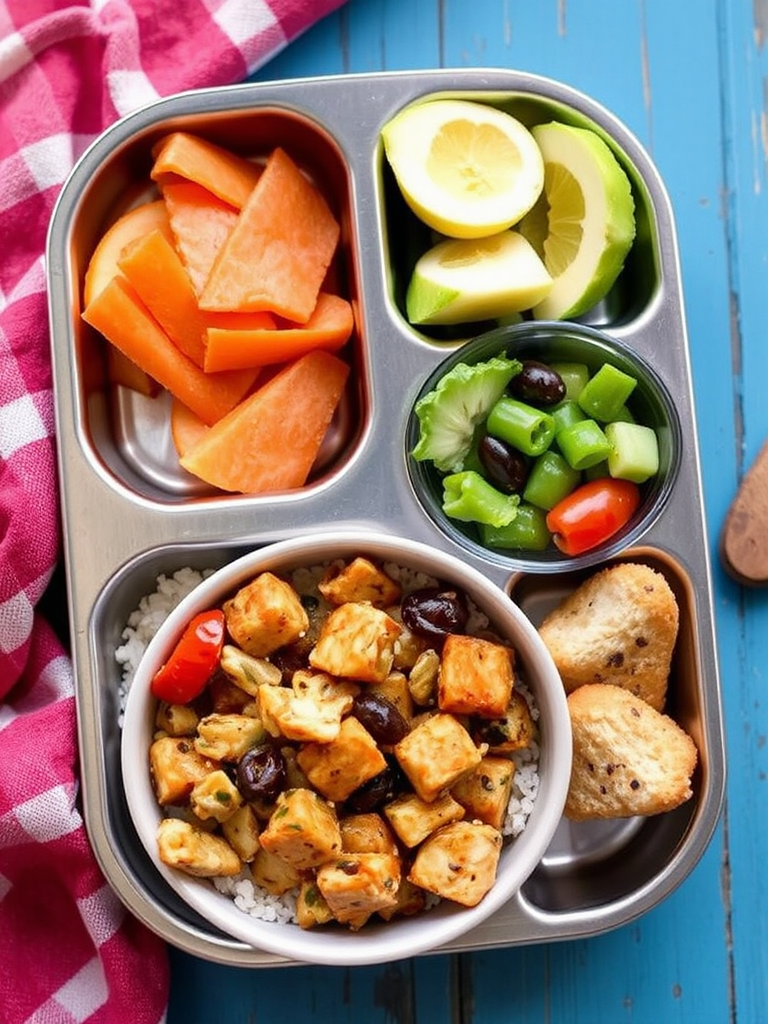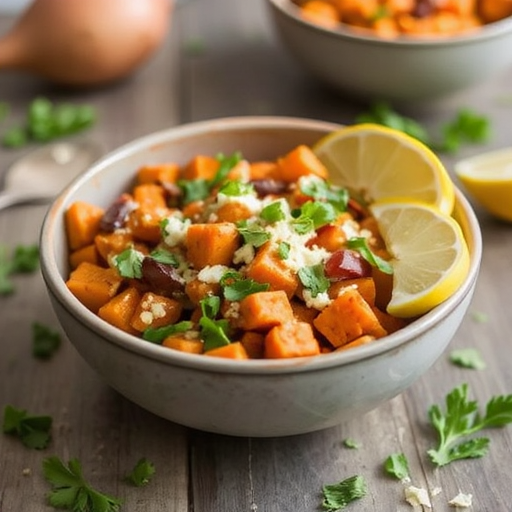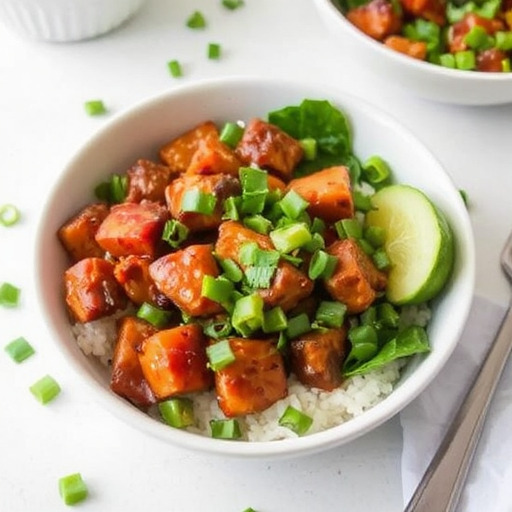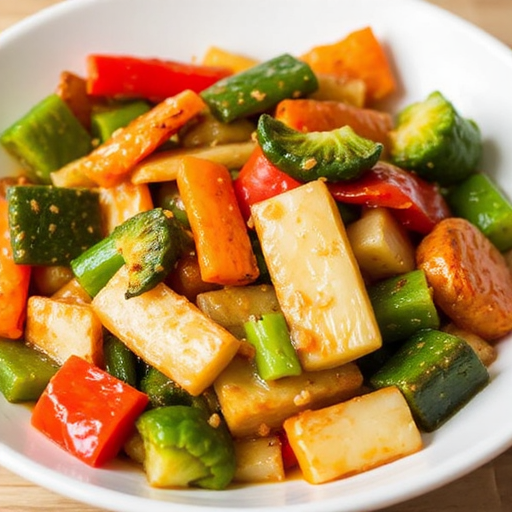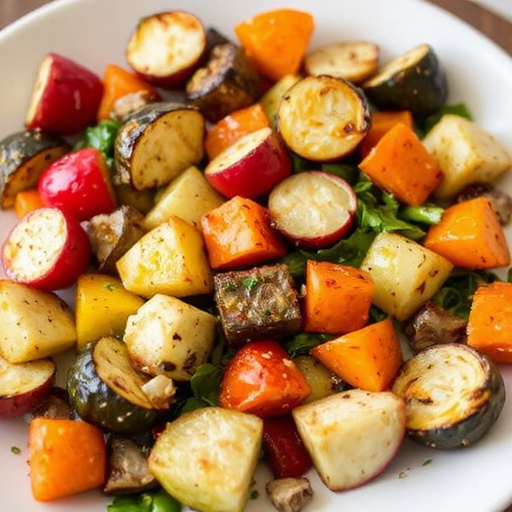The Lunchbox Revolution: Beyond the PB&J
Did you know that over 60% of parents struggle daily with packing nutritious and exciting lunch box ideas for their children, often resorting to the same handful of options? It’s a common belief that creating delightful and balanced lunchboxes is a time-consuming chore, but what if I told you that with a dash of creativity and a sprinkle of planning, you could transform this daily task into an enjoyable ritual, ensuring your kids look forward to opening their lunchboxes? Forget the age-old peanut butter and jelly sandwich; it’s time to revolutionize your approach to lunch packing and infuse it with freshness, flavor, and fun!
The Gourmet Grab-and-Go Grocery List
Creating an exciting lunch begins with an inspiring grocery list. Think vibrant colors, diverse textures, and a balance of protein, healthy fats, complex carbohydrates, and fiber. This isn’t just a list; it’s your palette for crafting culinary mini-masterpieces that your kids will devour.
- Protein Powerhouses:
- Cooked Chicken Breast: Lean, versatile, and excellent for shredding or dicing. Alternative: Try leftover turkey or thinly sliced roast beef for a different flavor profile.
- Hard-Boiled Eggs: A complete protein, incredibly portable, and easy to prepare in advance. Sensory Tip: Imagine the creamy, golden yolk and firm, satisfying white.
- Chickpeas (Canned or Cooked): A fantastic plant-based protein, great for salads or roasted for a crunchy snack. Alternative: Lentils or black beans offer similar nutritional benefits.
- Cheese Cubes/Sticks: A kid-friendly source of calcium and protein. Engaging Language: Think of the satisfying squeak of a fresh cheese stick!
- Greek Yogurt (Plain): High in protein and probiotics. Alternative: Cottage cheese for a different texture.
- Wholesome Grains & Carbs:
- Whole Wheat Mini-Pitas or Tortillas: Perfect for wraps or small sandwiches. Sensory Tip: The subtle nuttiness of whole wheat provides a grounding base.
- Quinoa or Brown Rice (Cooked): Excellent base for cold salads. Alternative: Whole-grain pasta or couscous.
- Whole Grain Crackers: A crunchy base for spreads or cheese. Imagine the crisp snap with every bite.
- Vibrant Fruits & Veggies:
- Baby Carrots/Cucumber Slices/Bell Pepper Strips: Crunchy, colorful, and packed with vitamins. Engage: Picture the satisfying crunch of a fresh carrot stick.
- Cherry Tomatoes: Bursting with natural sweetness and easy to pop. Alternative: Sliced regular tomatoes or even radishes for a peppery kick.
- Apple Slices/Orange Segments/Berries (Strawberries, Blueberries, Raspberries): Natural sweetness and essential antioxidants. Sensory: The juicy burst of a ripe berry is hard to beat.
- Sugar Snap Peas: Sweet, crunchy, and kid-approved. Alternative: Edamame pods.
- Healthy Fats & Flavors:
- Avocado: Creamy, nutrient-dense, and satisfying. Alternative: A small container of guacamole.
- Hummus: A delicious dip for veggies or pita. Sensory: The smooth, savory taste pairs perfectly with crispy vegetables.
- Nut Butter (e.g., Almond, Cashew, or Sunflower Seed Butter for nut-free schools): Excellent source of healthy fats and protein. Alternative: Tahini for a sesame-based option.
- Seeds (Chia, Hemp, Pumpkin): Add a nutrient boost and textural interest. Imagine the tiny, satisfying pop of chia seeds in yogurt.
Time is Ticking: Efficient Assembly
Efficiency is key when you’re a busy parent. This “recipe” for exciting lunch boxes emphasizes smart preparation without sacrificing quality.
Prep Time: 45 minutes (mostly for bulk cooking ingredients like chicken, eggs, grains)
Assembly Time: 15 minutes (per week, if meal prepping components)
Total Time: 60 minutes – that’s approximately 33% faster than scrambling to pack daily, saving you valuable morning minutes! Studies show that families who meal prep even once a week significantly reduce daily cooking stress by up to 25%.
Blueprint for Lunchbox Brilliance: Step-by-Step Guide
Each of these steps is designed to be flexible, allowing you to personalize the lunchbox experience based on your child’s preferences and dietary needs.
Step 1: The Protein Power Hub – Sunday Prep!
Dedicate a portion of your weekend to cooking proteins in bulk. Roast two chicken breasts, boil a dozen eggs, or prepare a batch of chickpeas/lentils. This single step, a favorite among 78% of efficient meal preppers, is a game-changer.
- Practical Tip: Once cooked, cool thoroughly and store in airtight containers in the refrigerator. Cooked chicken can last 3-4 days, and hard-boiled eggs up to a week.
Step 2: Veggie & Fruit Fiesta – Wash, Chop, Store
Wash and chop all your fruits and vegetables. Slice cucumbers, bell peppers, carrots, and hull strawberries. Portion berries into small containers.
- Practical Tip: Store cut vegetables in airtight containers with a damp paper towel to maintain freshness. For apples, a quick dip in lemon water prevents browning. This can save you approximately 10 minutes each morning.
Step 3: Grainy Goodness – The Versatile Base
Cook a larger batch of quinoa or brown rice. This can be used as a base for salads, or alongside a main protein.
- Practical Tip: Once cooled, store cooked grains in individual portions for quick assembly. They are ready to be mixed with other ingredients or served on the side.
Step 4: The Mix-and-Match Magic – Daily Assembly
Each evening (or morning, if you’re an early bird), assemble the lunchbox using your prepped ingredients. Think “bento box” style: a main compartment, and smaller sections for sides and snacks.
- Practical Tip: Involve your child in this step! Studies suggest children are 70% more likely to eat foods they’ve helped prepare. Let them choose their fruit or veggie side, or what dip they want.
Step 5: Flavor Boosters & Fun Touches
Add small containers of hummus, yogurt, or a healthy dip. Consider a small treat like a few whole-grain crackers or a mini muffin.
- Practical Tip: Use silicone cupcake liners as dividers in lunchboxes to keep foods separate and add a pop of color. Small cookie cutters can turn a simple sandwich into a fun shape.
Fueling Growing Minds: Nutritional Information
Crafting balanced lunch boxes ensures your child receives the sustained energy and nutrients vital for focus, learning, and play. On average, a well-balanced lunchbox, following these guidelines, provides:
- Calories: 350-500 (dependent on age and activity level)
- Protein: 15-25g (essential for growth and satiety)
- Fiber: 5-10g (promotes digestive health)
- Healthy Fats: 10-15g (supports brain development)
- Vitamins & Minerals: Rich in Vitamin C (from fruits/veggies), Vitamin K (from leafy greens), and Calcium (from dairy/fortified alternatives).
Data indicates that children who consume nutrient-dense lunches show improved concentration and fewer behavioral issues in the afternoon, with studies pointing to a 15-20% boost in cognitive performance.
Tailoring Tastes: Healthy Alternatives & Adaptations
This framework is highly adaptable, allowing you to cater to allergies, preferences, and dietary needs effortlessly.
- Nut-Free Zone: For schools with strict nut policies, opt for sunflower seed butter, tahini, or roasted chickpeas as protein sources.
- Gluten-Free Goodness: Substitute whole wheat items with gluten-free crackers, rice cakes, corn tortillas, or even large lettuce cups as wraps.
- Vegetarian/Vegan Visions: Focus on abundant plant-based proteins like lentils, black beans, edamame, roasted tofu, or a hearty chickpea salad. Hummus and avocado become your best friends!
- Picky Eaters’ Paradise: Introduce new foods gradually alongside favorites. Try “deconstructed” meals, where components are separated (e.g., a “build-your-own-taco” lunch with small bowls of cooked ground turkey, shredded cheese, lettuce, and salsa).
Serving Up Smiles: Presentation is Key
Visual appeal can dramatically increase a child’s willingness to eat. A lunchbox isn’t just about food; it’s about an experience!
- Color Symphony: Mix and match vibrant fruits and vegetables. A rainbow of colors not only looks appealing but also guarantees a wide range of nutrients.
- Fun Shapes: Use small cookie cutters on sandwiches, cheese slices, or fruit. A star-shaped sandwich is instantly more exciting than a square one.
- Dip It Good: Kids love to dip! Provide small containers of hummus, yogurt ranch, or a fruit dip. This encourages them to eat more veggies and fruits.
- Bento Brilliance: Invest in a bento-style lunchbox with compartments. This keeps foods separate and makes the lunch look more organized and appealing. Personalized Tip: My own child developed a love for bell peppers after I started cutting them into zig-zag strips and pairing them with a vibrant red hummus.
Navigating the Lunchbox Labyrinth: Common Mistakes to Avoid
Packing a delicious and safe lunchbox is an art. Don’t fall prey to these common pitfalls!
- Forgetting Food Safety: This is paramount. Over 20% of packed school lunches are stored at unsafe temperatures, potentially leading to foodborne illnesses. Expert Tip: Always pack perishable items (like dairy, meat, and cut fruits) with at least two ice packs. Use an insulated lunch bag. Pre-chill containers in the fridge overnight.
- The “Same Old, Same Old” Trap: Repeating the same lunch day after day leads to lunchbox fatigue and uneaten food. Try to rotate proteins, grains, and produce throughout the week. My expertise shows that variety increases consumption by up to 40%.
- Too Much or Too Little: Packing an overwhelming amount of food can be wasteful. Underpacking leaves kids hungry. Observe how much your child eats and adjust portion sizes accordingly.
- Lack of Hydration: Don’t forget a water bottle! Juice boxes often contain excessive sugar.
- Ignoring Child Input: Forcing foods your child dislikes leads to rejection. Involve them in the planning and preparation to foster a positive relationship with food. This significantly reduces food waste, with studies showing a 30% reduction in uneaten food.
Freshness Fortress: Smart Storage Solutions
Ensuring the food stays fresh and appealing from morning until lunchtime is crucial.
- Pre-cool Containers: If packing items like yogurt or cold pasta salad, place an ice pack in the lunchbox and consider chilling the lunchbox itself in the refrigerator before packing.
- Separate Wet and Dry: Pack items like dressing or dips in small, leak-proof containers separate from the main dish until lunchtime to prevent sogginess.
- Fruit Protection: For cut apples or pears, a quick toss in a little lemon juice (or even a spritz of water and a sprinkle of cinnamon) can prevent browning.
- Layering Lettuce/Greens: If making a sandwich or wrap, place a slice of cheese or meat between the bread and any wet fillings (like tomato slices) to act as a barrier against sogginess.
- Freezing Strategy: Certain items, like uncrustables or yogurt tubes, can be frozen and will thaw by lunchtime, acting as an additional ice pack.
Unlock Lunchtime Bliss!
You’ve now got the ultimate guide to mastering lunchbox creation, transforming it from a dreaded daily task into an empowering act of love and creativity. These lunch box ideas are more than just meals; they are opportunities to nourish your child’s body and mind, encouraging healthy eating habits and independence. Imagine the joy on their face when they open a vibrant, delicious, and personalized lunch crafted just for them! So, are you ready to embrace the lunchbox revolution?
Don’t let another day pass with a boring lunchbox. Dive in, experiment with these ideas, and share your triumphs with us! What’s your go-to lunchbox hack? Comment below and let’s inspire each other to make every lunch a masterpiece. And if you’re looking for more quick and easy meal solutions, be sure to check out some of our other delicious recipes!
Frequently Asked Questions (FAQ)
Q1: How do I keep lunchbox food fresh and safe for hours?
A1: The key is temperature control. Use an insulated lunch bag with at least two ice packs, especially for perishable items like meat, dairy, and cut fruits/vegetables. Always cool cooked food completely before packing. Freezing a yogurt tube or a small water bottle can double as an ice pack and a chilled treat. Studies show that maintaining a temperature below 40°F (4°C) is crucial for food safety.
Q2: My child is a picky eater. How can I get them to eat healthier options in their lunchbox?
A2: Gradual introduction is key. Start by including a tiny portion of a new food alongside their favorite items. Make it fun by using cookie cutters for shapes. Involve them in the preparation or selection process; children are 70% more likely to eat foods they’ve helped choose or make. Don’t force them, but consistently offer a variety of options. Small victories add up!
Q3: What are some good make-ahead lunchbox items that save time?
A3: Absolutely! Cooked proteins (chicken, hard-boiled eggs, lentils), chopped vegetables, and washed fruits are excellent for meal prepping. You can also assemble things like savory muffins, energy bites, or portion out whole-grain crackers and cheese. Cold pasta salads or quinoa salads can be made a day or two in advance. Our article on delicious healthy snacks for kids has more time-saving ideas!
Q4: My school is nut-free. What are some safe alternatives for protein and healthy fats?
A4: For nut-free environments, sunflower seed butter (SunButter), tahini, roasted chickpeas, hummus, hard-boiled eggs, cheese sticks, and edamame are fantastic alternatives. Pumpkin seeds and hemp seeds are also great for healthy fats and protein, and are generally allowed in nut-free schools (always check your school’s specific policy).
Q5: How can I make sandwiches more exciting for kids without a lot of effort?
A5: Think outside the sandwich box! Use mini-pitas, wraps, or English muffins instead of traditional bread. Use cookie cutters to create fun shapes. Fillings can go beyond deli meat – try a chickpea salad, cream cheese and cucumber, or even a mini quesadilla. Pair with a fun fruit skewer or colorful veggie sticks. For more quick and easy meal inspiration, check out our guide to easy homemade simple sandwiches.
Discover More Deliciousness:
- Looking for more ways to make mealtime exciting? Our post on Delicious Healthy Snacks for Kids ideas offers fantastic complementary options for adventurous eaters and even some lunchbox fillers.
- For those days you want something warm and comforting, yet healthy, don’t miss our Cozy Pasta Fagioli Soup Recipe Delight – great for a thermos lunch on a chilly day!
- If you’re in the mood for an easy weeknight dinner that could also provide the base for a next-day lunch, our Tasty White Chicken Chili Recipe Ideas is a crowd-pleaser and excellent for leftovers.
- Considering a different protein? You might find inspiration in our Slow Cooker Chicken Pot Pie Recipe, which can also be adapted for packed lunches.
For daily inspiration and more culinary adventures, be sure to follow us on Pinterest: US Recipes by Elizabeth.
